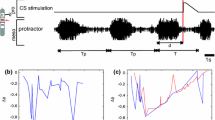Abstract
The co-ordination of the walking behaviour of decerebrate stick insects is examined and compared with normal behaviour. The walks are fully coordinated but undergo subtle changes in timing, have a longer average step period and show momentary pauses of 50 ms during the time course of protraction movements. In addition a new intersegmental reflex has been discovered. This tactile reflex is used to avoid errors in co-ordination that would be produced by posterior legs stepping onto the tarsi of the legs in front. The reflex has a latency of 100 ms and is easily observed in lesioned animals but is also active, although seldom seen, in slowly walking intact animals.
Similar content being viewed by others
References
Bässler, U.: Sensory control of leg movement in the stick insect Carausius morosus. Biol Cybernetics 25, 61–72 (1977)
Buddenbrock, W.v.: Vergleichende Physiologie. Vol I (Sinnes) Physiologie. Basel: Birkhäuser 1952
Burns, M.D.: The control of walking movements in Orthoptera. J. Exp. Biol. 58, 45–58 (1973)
Cate, T. ten: Physiologie der Gangliensysteme der Wirbellosen. Ergeb. Physiol. 33, 137–336 (1931)
Cruse, H.: The control of the anterior extreme position of the hind leg of a walking insect (Carausius morosus). Physiol. Entomol. (in press)
Delcomyn, F.: Reflexes and locomotion in the american cockroach. Ph.D. Thesis. University of Oregon (1969)
Graham, D.: An analysis of walking movements in the first instar and adult stick insect Carausius morosus. J. comp. Physiol. 81, 23–52 (1972)
Graham, D.: A model for the control of coordinated leg movements in free walking insects. Biol. Cybernetics 26, 187–198 (1977a)
Graham, D.: The effect of amputation and leg restraint on the free walking coordination of the stick insect Carausius morosus. J comp. Physiol. 116, 91–116 (1977b)
Graham, D.: Effects of circum-oesophageal lesion on the behaviour of the stick inset Carausius morosus. I. Cyclic behaviour patterns. Biol. Cybernetics 32, 139–145 (1979)
Graham, D.: Unusual step patterns in the free walking grasshopper Neoconocephalus robustus. II. A critical test of the leg interactions underlying different models of hexapod coordination. J. Exp. Biol. 73, 159–172 (1978)
Lang, J.: Die Stimulation des Bewegungsreflexes bei dekapitierten Carausius morosus und Tenebrio moliter durch Temperaturreizung der Tarsalglieder. Biol. Zbl 52, 582–584 (1932)
Wiersma, C.A.G.: On the number of nerve cells in a central nervous system. Acta physiol. Pharm. 6, 135–142 (1957)
Wendler, G.: Verh. Deutsch. Zool Ges. p. 214 (1971)
Author information
Authors and Affiliations
Rights and permissions
About this article
Cite this article
Graham, D. Effects of circum-oesophageal lesion on the behaviour of the stick insect Carausius morosus . Biol. Cybernetics 32, 147–152 (1979). https://doi.org/10.1007/BF00337391
Received:
Issue Date:
DOI: https://doi.org/10.1007/BF00337391




